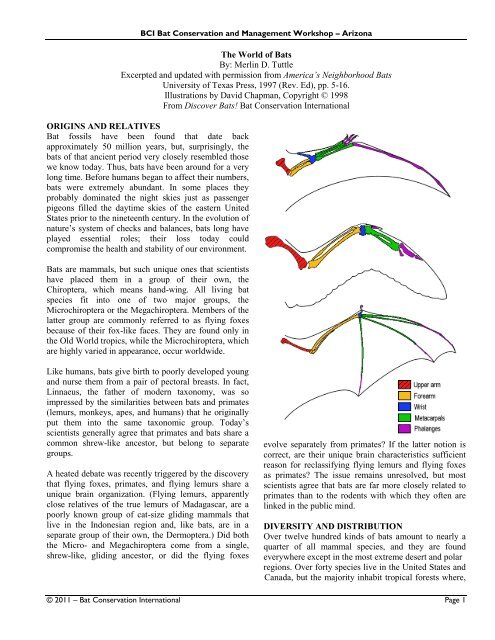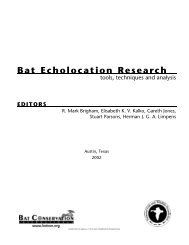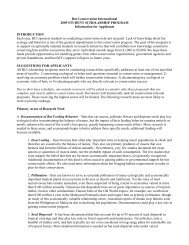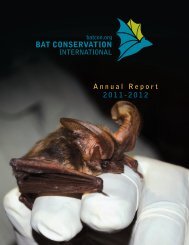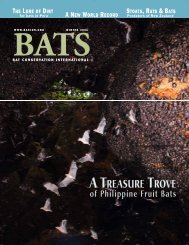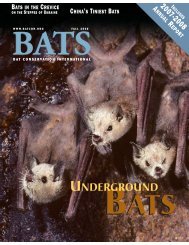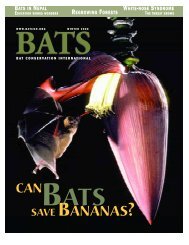Bat Conservation and Management Workshop
Bat Conservation and Management Workshop
Bat Conservation and Management Workshop
Create successful ePaper yourself
Turn your PDF publications into a flip-book with our unique Google optimized e-Paper software.
BCI <strong>Bat</strong> <strong>Conservation</strong> <strong>and</strong> <strong>Management</strong> <strong>Workshop</strong> – Arizona<br />
The World of <strong>Bat</strong>s<br />
By: Merlin D. Tuttle<br />
Excerpted <strong>and</strong> updated with permission from America’s Neighborhood <strong>Bat</strong>s<br />
University of Texas Press, 1997 (Rev. Ed), pp. 5-16.<br />
Illustrations by David Chapman, Copyright © 1998<br />
From Discover <strong>Bat</strong>s! <strong>Bat</strong> <strong>Conservation</strong> International<br />
ORIGINS AND RELATIVES<br />
<strong>Bat</strong> fossils have been found that date back<br />
approximately 50 million years, but, surprisingly, the<br />
bats of that ancient period very closely resembled those<br />
we know today. Thus, bats have been around for a very<br />
long time. Before humans began to affect their numbers,<br />
bats were extremely abundant. In some places they<br />
probably dominated the night skies just as passenger<br />
pigeons filled the daytime skies of the eastern United<br />
States prior to the nineteenth century. In the evolution of<br />
nature‘s system of checks <strong>and</strong> balances, bats long have<br />
played essential roles; their loss today could<br />
compromise the health <strong>and</strong> stability of our environment.<br />
<strong>Bat</strong>s are mammals, but such unique ones that scientists<br />
have placed them in a group of their own, the<br />
Chiroptera, which means h<strong>and</strong>-wing. All living bat<br />
species fit into one of two major groups, the<br />
Microchiroptera or the Megachiroptera. Members of the<br />
latter group are commonly referred to as flying foxes<br />
because of their fox-like faces. They are found only in<br />
the Old World tropics, while the Microchiroptera, which<br />
are highly varied in appearance, occur worldwide.<br />
Like humans, bats give birth to poorly developed young<br />
<strong>and</strong> nurse them from a pair of pectoral breasts. In fact,<br />
Linnaeus, the father of modern taxonomy, was so<br />
impressed by the similarities between bats <strong>and</strong> primates<br />
(lemurs, monkeys, apes, <strong>and</strong> humans) that he originally<br />
put them into the same taxonomic group. Today‘s<br />
scientists generally agree that primates <strong>and</strong> bats share a<br />
common shrew-like ancestor, but belong to separate<br />
groups.<br />
A heated debate was recently triggered by the discovery<br />
that flying foxes, primates, <strong>and</strong> flying lemurs share a<br />
unique brain organization. (Flying lemurs, apparently<br />
close relatives of the true lemurs of Madagascar, are a<br />
poorly known group of cat-size gliding mammals that<br />
live in the Indonesian region <strong>and</strong>, like bats, are in a<br />
separate group of their own, the Dermoptera.) Did both<br />
the Micro- <strong>and</strong> Megachiroptera come from a single,<br />
shrew-like, gliding ancestor, or did the flying foxes<br />
evolve separately from primates? If the latter notion is<br />
correct, are their unique brain characteristics sufficient<br />
reason for reclassifying flying lemurs <strong>and</strong> flying foxes<br />
as primates? The issue remains unresolved, but most<br />
scientists agree that bats are far more closely related to<br />
primates than to the rodents with which they often are<br />
linked in the public mind.<br />
DIVERSITY AND DISTRIBUTION<br />
Over twelve hundred kinds of bats amount to nearly a<br />
quarter of all mammal species, <strong>and</strong> they are found<br />
everywhere except in the most extreme desert <strong>and</strong> polar<br />
regions. Over forty species live in the United States <strong>and</strong><br />
Canada, but the majority inhabit tropical forests where,<br />
© 2011 – <strong>Bat</strong> <strong>Conservation</strong> International Page 1


